My Impressions from SCaLE 2010
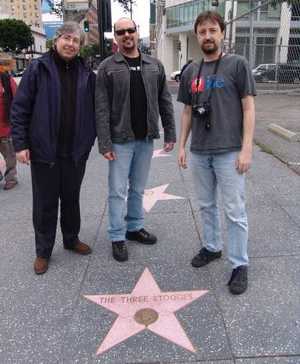 From right to left: Scott, Bruno and myself (the three Haiku stooges?) at the Hollywood Walk of Fame.
From right to left: Scott, Bruno and myself (the three Haiku stooges?) at the Hollywood Walk of Fame.
The Southern California Linux Expo – or the SCaLE show as it is also widely known – was the very first mainstream open source conference that Haiku exhibited at. This was back in February of 2007, when Michael Phipps, Axel Dorfler, Bruno G. Albuquerque and myself gathered in LA to show Haiku to the world for the first time (photos here). Following the once a year tradition that SCaLE has become since then, Bruno G. Albuquerque, Scott McCreary and myself gathered to represent Haiku at the SCaLE 2010 conference, recently held in Los Angeles on the weekend of February 20th and 21st.
On Saturday morning, the three of us gathered on the exhibit floor at around 9:00AM, one hour before the exhibition was scheduled to open to the public. This gave us plenty of time to prepare the booth, especially because we had already setup the projector screen on the backwall the evening before. We placed the HAIKU table runner over the 7 feet long table that we had at the booth, and then laid out – from left to right – Scott's AMD dual core laptop, my small cube-sized Intel dual core desktop hooked to a projector, and an 8-core laptop that belonged to Bruno's girlfriend. As handouts, we had the new Haiku flier as well as 50 alpha 1 CDs that Scott had burned on Lightscribe media.
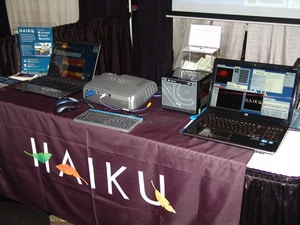 A closeup of the table at the our booth.
A closeup of the table at the our booth.Saturday morning was a very busy time. We had heard from the SCaLE folks that registration was up from last year, so we expected quite a bit of traffic; but the sheer amount of people that were on the exhibit floor that morning simply surpassed all our expectations. Which was good, of course, and not much of a problem, considering that we were three people manning the booth. Scott, who had never been to SCaLE before, was apparently quite surprised, and could not help but ask me how I was able to do the show alone...
We did our usual demo routines, as we usually do when showcasing Haiku at conferences. Development related questions were, whenever possible, referred to Bruno (it's really nice to have a developer at hand), while Scott and myself focused more on general introductions and end-user focused hands-on demos. It had been several months since I last installed and used Haiku on my dual core PC, and I have to say that I was very impressed with the gains achieved in features, performance and stability since then. Showing off Haiku is a blast!
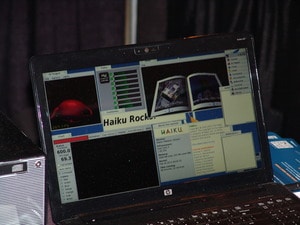 8-core laptop running Haiku. Great demo machine indeed!
8-core laptop running Haiku. Great demo machine indeed!
As I usually do, I also walked around the exhibits to see what other projects had to show. One of the booths that I visited was that of Gnome; not only is it my DE of choice when I use Ubuntu, but their booth also had an impressive display with two very big LCD monitors side by side hooked up to a dual-head display adaptor; very eye-catching indeed. I spoke a bit with one of the guys manning the booth, and when I identified myself as being from the Haiku project, he “confessed” to being a former BeOS user and fan; needless to say, I came back later and made sure he took a Haiku CD with him. Who knows, maybe he even converts. :)
My tour of the exhibit floor took me to the Drupal booth, the one project that I always make a point of visiting when I attend open source conferences. I have done quite a bit of web development using Drupal over the last few years, including the Haiku website, and I like to talk to the developers at hand to stay up to date and see what's coming down the line. What pleasantly surprised me was to see the Haiku website – which, ehem, I designed – included in the slideshow of prominent websites they were displaying in their booth. Call me selfish if you want, but that alone made me feel really good. :)
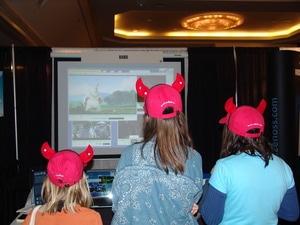 We were also a hit among the younger audience. ;)
We were also a hit among the younger audience. ;)This being the fourth time we exhibited at SCaLE, it was interesting to use this event as a yardstick to see how both the level awareness and perception of Haiku has changed over time. From all the activity, development-related and otherwise, that has occurred around Haiku since we first came to the conference in early 2007, a higher level of awareness is natural and expected. But also what I did notice and found interesting (even compelling) was how the perception of Haiku as a piece of software and as a project has changed; in talking to people, seeing their reactions and listening to their comments, from SCaLE I came with the strong impression that Haiku is leaving behind the status of “obscure project that most people thought would never get anywhere” to finally become a movement that more and more people are starting to take seriously.
To me, nothing reinforces this notion more than seeing former BeOS developers admiring Haiku in awe and expressing their desire to return to the platform. We actually had a couple of them at SCaLE. The first prospective returnee that showed up at our booth was Mark Iuzzolino; a former registered BeOS developer who, if I remember correctly, mentioned he had done game development. Mark spent a long time talking about Haiku with Bruno, and hang out with us during both days of the exhibition; he clearly expressed his desire to make a come back, so let's look forward to that day. We also met with Michael Aramida, the author of QueryWatcher, my favorite BFS-related utility during the BeOS/ZETA days (if you have never used it, you should definitely try it!). I had contacted Michael a couple of months ago to ask whether he would support Haiku; as it turned out, he lives in LA (which I did not know); so I invited him to join us at SCaLE, which he did: he came to see us on Sunday, and after the show we enjoyed his company during our last supper in LA. To me, that people who once (understandably) moved on from BeOS development now feel the desire to take a hard look at Haiku says a lot both about the progress that our project and OS has made, as well as to how compelling Haiku can still be even in today's world of personal computing which has changed so much since the days of BeOS.
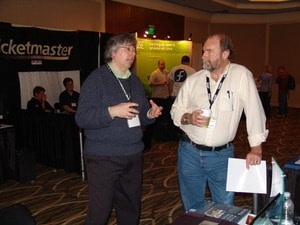 Here I am talking about Haiku with one of guys from the KDE booth.
Here I am talking about Haiku with one of guys from the KDE booth.We had the surprising visit to our booth of Rob Savoye, the primary developer of the Gnash open source Flash player. Rob's interest in Haiku was sparked by the recent release of Gnash 0.8.7 for Haiku; he was so impressed by the good work done by Adrian Panasiuk, that he decided he wanted to integrate his work into Gnash's trunk (which he did after SCaLE). Rob gave a Gnash talk at SCaLE, and according to himself, he mentioned Haiku during his presentation (mp3 audio here). Scott and myself bumped into Rob late at night after dinner, and we spend quite a bit of time talking about various topics. Quite an interesting fellow indeed. :)
We wrapped up the first day with a Haiku BoF (birds of a feather) informal presentation which we gave in one of the smaller conference rooms. Bruno did most of the talking, I handled the on-screen demo as he spoke (the room had a projector and a huge screen), and both Scott and myself jumped in here and there with additional information where needed. The audience was relatively small (I counted 15 people), but that's understandable, as the time slot we were given was 7 – 8 PM, which is when most people are already either having dinner or drinking in the bar. :)
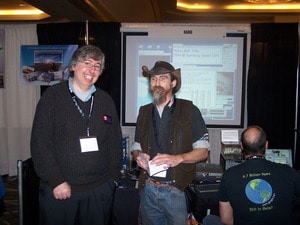 Rob Savoye (right), Gnash developer, and myself at the Haiku booth.
Rob Savoye (right), Gnash developer, and myself at the Haiku booth.Perhaps the low point of this year's SCaLE was the fact that we could not land any talks. Bruno and Ryan (Leavengood) had each applied for a speaker slot, but both applications were rejected. This was very unexpected, as they had postponed the call for papers deadline, which I read as a sign that they did not have many applications; as it turned out, the deadline extension was followed by a rush of applications, and they had so many of them, that a they had to leave out a lot of very good proposals, including those from Bruno and Ryan. In retrospect, there is probably not much that we could have done, other than perhaps spice up the applications a bit to make them more compelling or even perhaps provocative (like Niels' recent “Haiku has no future” presentation at FOSDEM 2010, which is a good example of a thought-provoking title). As disappointing as it was, we take this as another learning experience that will most probably teach us how to do better next time.
Sunday was much slower compared to the first day. Perhaps understandably (you know, all those late dinners and drinks...), not many people showed up at the exhibit floor until after 11:00 AM. Traffic did pick up towards noon time, so we kept doing our booth routine, showing off Haiku, and handing out fliers and Haiku CDs. Talking about handouts, during the two days of the show, we gave away about 250 Haiku fliers and all the 50 alpha 1 CDs that Scott had burned; in spite of being quite selective when handing out the CDs, we still ended up with only a few left by Sunday morning.
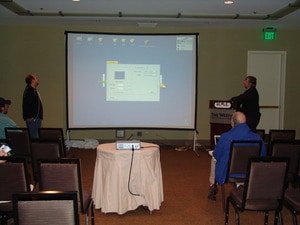 Here we are preparing for the Haiku birds of a feather talk that we gave at SCaLE.
Here we are preparing for the Haiku birds of a feather talk that we gave at SCaLE.Since Sunday morning was slow, I took the opportunity to visit the KDE booth; not that I am a fan of KDE, but I like to follow these projects, as they can be useful as a point of reference (you never know where you can learn something new from). After being given a brief demo from one of the guys at their booth, I ended up taking him to our booth to show him what Haiku was about. This gentleman had never actually seen our OS, and in the end, I spent close to 45 minutes talking and showing him the various unique aspects of the system. I could tell he was quite amazed at how fast, and since he took one of the last CDs with him, I am pretty sure he must have it now installed in one of his PCs by now. :)
One other aspect that we did not do quite well this year was taking donations. We attribute this to the lack of incentives; in the past, we used T-shirts and more recently USB thumbdrives as incentives for people to donate; we had neither this year. With Scott we thought it would be good to look into this for future events, like having quality CDs and t-shirts to give in exchange for small donations. Anyway, this is a topic for future discussion that we plan to bring up on the Haiku mailing list some day, as it would be good to take up on this as a project-wide initiative in order to take advantage of economy of scale.
Overall, SCaLE was both productive and enjoyable, as expected. This is still my favorite open source conference (OSCON comes as a very close second), so I look forward to coming back next year. It will be very interesting to see what we will be able to show a year from now. Given all the recent developments, and being the optimist that I tend to be, we may even have an R1 available for SCaLE 2011, who knows.
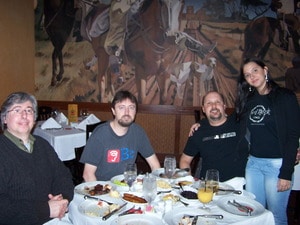 Bruno invited us to a Brazilian BBQ restaurant; from right to left: Solange (Bruno's girlfriend), Bruno, Scott and myself.
Bruno invited us to a Brazilian BBQ restaurant; from right to left: Solange (Bruno's girlfriend), Bruno, Scott and myself.Let me finish with some words of gratitude and encouragement. First, I want to to thank a few people: Stippi for providing an early binary of the native Haiku browser, which I demoed to show that the webkit port was not vapourware; Rene Gollent for helping me out produce a stable build from trunk for my demo machine; the Haiku Inc. folks for fully supporting our effort at SCaLE; Bruno for coming all the way from Brazil to make the SCaLE experience a much more enjoyable one (Bruno, that Brazilian BBQ was the best!); Scott for giving me the motivation to go to LA for SCaLE and being there; and last but not least, all the developers and other contributors who have put so much into making Haiku what it is today. I see Haiku making great strides on so many fronts, that I can't help but feel very encouraged about it's future. Everyone, keep up the good work!
koki's blog
- My Impressions from SCaLE 2010
- The History Channel: 2003 Interview with Michael Phipps
- What do You Know About the Haiku Logo?
- OSCON & OpenSource World 2009 Double Report
- Haiku Coming to OSCON 2009 in San Jose
- Testing CSS Styles from Haiku User Guide
- Haiku at SCaLE 2009: the Report
- LinuxWorld 2008 as I saw it
- Video: Code_Swarm for Haiku
- Haiku Code Drive: May 16 update




